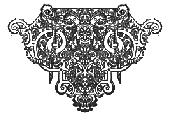
Every student project on ECE requires an annotated bibliography that can
be accessed from the front page of the project site. The bibliography
lists every book, article, and web site that you draw upon in conducting
the research for your project. Each entry in the bibliography should be
formatted according to Chicago
Style guidelines, and should include several sentences describing
and evaluating the source. The finished bibliography should resemble the
model provided
here.
On this page you'll find some ideas on how to identify useful sources for your project. It's often helpful to begin with encyclopedias or other reference works to get a broad overview of your topic. Next you'll want to use MIRLYN to find books that offer a more in-depth treatment of your topic. Articles in scholarly journals are often very helpful sources of information about specific aspects of a topic. And finally, primary sources from the eighteenth century are indispensible sources of the kinds of writings and images related to your topic that can give your project a real sense of historical depth and authenticity.
Always bear in mind as you begin gathering and working with your research material that the aim of the project is not simply to reproduce or re-arrange a set of historical facts, but rather to interpret, question, and engage with those facts and the interpretations of other scholars who have considered them. Your readers will want to know not just "what happened," but also how we can make sense of this and why this might be interesting and significant to us today. The heart of the project is not in the information you glean from the sources in your bibliography, in other words, but rather in your own imaginative engagement with that information.
The Library Catalog
- You can search for books on your topic in the University of Michigan Library Catalog (MCAT) using MIRLYN. Here are some links to sites that will help you track down the books you need:
- Classic MIRLYN Basics - an introduction to the telnet version of the online library catalog
- MIRLYNWeb Basics - an introduction to the web interface to the online library catalog
- MIRLYN
Keyword Searching - searching by keyword is often the best way to
start with a general search
- Library Navigator - helps you locate library materials once you've got their call numbers
- Understanding call numbers (PDF File) - explanations of what call numbers mean and how they are arranged
Journal Article Indexes
- Article
First
The Article First database allows for content searches in various journals in science, technology, medicine, social sciences, business, the humanities, and popular culture. The database is updated daily and includes over 12,600 periodicals. - Periodical Contents Index
The Periodical Contents Index is an electronic index to the contents in over 2000 journals in the humanities and social sciences. The index includes international journals including French, German, Spanish and other Western languages. - Historical
Abstracts
Indexes and summarizes articles in 2,000+ history journals. Covers political, diplomatic, economic, social, cultural, and intellectual history since 1450, excluding American and Canadian history. - Modern Language
Association Bibliography (MLAB) (accessed via MIRLYN)
Index to international critical journal literature and books on literature, languages, linguistics and folklore. This is the best place to start for research on specifically literary topics. - WILS
(accessed via MIRLYN)
A combination of 14 indexes covering a wide variety of subjects, representing mainstream scholarly journals, popular magazines and some books. Provides citations to articles, essays in collections, book and film reviews.
Other Search Strategies:
- Keyword searching is generally the best way to begin a general search in any index, as it searches all fields of the catalog entries, including title and subject.
- When you browse your initial keyword search results in MIRLYN or a journal index, pay special attention to the "Subject Headings" assigned to each item. Once you find a particularly promising source, doing a second search based on the subject headings from that source will often turn up similar books or articles that you might have missed in your initial keyword search.
- Once you've found a book or article that seems particularly interesting or useful, be sure to browse that source's bibliography and footnotes for other potentially useful sources. This is often called "footnote-chasing," and it can often be one of the most efficient ways of building up a research bibliography.
Go on to Research and Reference Resources
